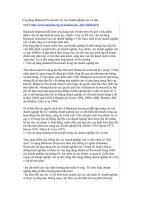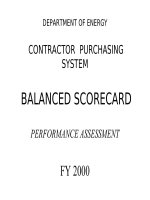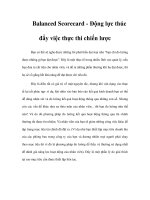Berliner Balanced Scorecard Customer Perspective
Bạn đang xem bản rút gọn của tài liệu. Xem và tải ngay bản đầy đủ của tài liệu tại đây (1.24 MB, 21 trang )
Prof. Dr. Wilhelm Schmeisser; Lydia Clausen; Martina
Lukowsky
Berliner Balanced Scorecard: Customer
Perspective
Download free books at
Download free eBooks at bookboon.com
2
Prof. Dr. Wilhelm Schmeisser, Lydia Clausen and Martina Lukowsky
Berliner Balanced Scorecard:
The Customer Perspective
Download free eBooks at bookboon.com
3
Berliner Balanced Scorecard: The Customer Perspective
1
st
edition
© 2008 Prof. Dr. Wilhelm Schmeisser, Lydia Clausen and Martina Lukowsky &
bookboon.com
ISBN 978-87-7681-233-2
Download free eBooks at bookboon.com
Click on the ad to read more
Berliner Balanced Scorecard:
The Customer Perspective
4
Contents
Contents
1 From product-to customer prot contribution 5
1.1 Product- versus customer-based calculation 5
1.2 Activity-based costing 6
2 From customer prot contribution to customer cash ow 13
3 Calculated investment summary of the customer value 15
3.1 Determining the adequate target rate 16
3.2 Field of application for the customer value and interpretation of the results 16
4 e index hierarchy of the customer perspective 17
5 Combining the shareholder value and the balanced scorecard 18
6 Conclusion and outlook 19
List of Sources: 20
Endnotes 21
www.sylvania.com
We do not reinvent
the wheel we reinvent
light.
Fascinating lighting offers an infinite spectrum of
possibilities: Innovative technologies and new
markets provide both opportunities and challenges.
An environment in which your expertise is in high
demand. Enjoy the supportive working atmosphere
within our global group and benefit from international
career paths. Implement sustainable ideas in close
cooperation with other specialists and contribute to
influencing our future. Come and join us in reinventing
light every day.
Light is OSRAM
Download free eBooks at bookboon.com
Berliner Balanced Scorecard:
The Customer Perspective
5
From product-to customer prot contribution
Companies are increasingly attempting to replace or expound product-orientated strategies by customer-
orientated strategies. For this reason, the quantication of customer relations within the scope of the
balanced scorecard is increasingly achieving signicance as an implementation instrument for strategies
and as a supplement to classic product protability analysis.
1 From product-to customer
prot contribution
e customer prot contribution accounting enables a more precise assignment of direct costs as well
as indirect costs (distribution, marketing and order processing), which were -up to now- only broken
down into percentages by the help of activity based costing, to the cost unit “customer” by means of
additional allocation bases. By using th`is method, it is possible to evaluate the protability of the
customer. e knowledge of the protability of individual customers oers both starting points for cost
cutting measures, and an opportunity to conduct an improved customer and yield management, and so
ultimately enhance the protability of the entire company.
In the following, instead of the product prot contribution, the customer prot contribution is taken
as a starting point and ultimately conveyed in a customer cash ow. e investment calculation of the
customer value shall also be explored as well as its role in enhancing the company and/or the market
value within the scope of the quantication of the balanced scorecard.
1
1.1 Product- versus customer-based calculation
A company management will not be able to forgo a product-based calculation, as the processes of
planning, managing and controlling are initially xed to the product or service to be performed. For
company internal processes, the product costs are most relevant as long as no customer-specic order
requests are taken into account, which are directly assigned to the product concerned. e following
diagram is intended to provide a rough schematic overview of the process for determining the customer
prot contribution amount, in which an initial product-based calculation is performed and through
which the characteristics of the customer-based product calculation are revealed.
Download free eBooks at bookboon.com
Berliner Balanced Scorecard:
The Customer Perspective
6
From product-to customer prot contribution
Product costing Customer costing
-
-
Sales
Sales deductions
Variable costs
= Product prot contribution I
-
=
-
Product prot contribution I
Direct customer costs
Customer prot contribution I
Indirect customer costs
(as far as variable in relation to number of
customers)
= Customer prot contribution II
Diagram 1: Product versus customer costing (accruals accounting) Source: Comp. Schirmeister, R./ Kreuz, C. (2003), p. 338.
e “indirect customer costs“ are broken down dierentiated via activity-based costing and thus assigned
cost reectively. In this way, it is possible to substantially increase the signicance of the customer prot
contribution.
1.2 Activity-based costing
Activity-based costing provides a formula, which usage enables a better planning and managing of costs
in indirect company sectors or allocating them to products or services. e transacted functions in the
enterprise’s cost centers are broken down into process-based activities. e costs, subjective to so-called
cost drivers are assigned to these activities and activity cost rates are thus calculated.
2
factorprocesspercost
quantityprocess
costsprocess
ratecostProcess
Example
3
: process “material purchase and storage”
Process costs = 7 605 000 €
Process factor = outlay process
Process quantity = 650 000 €
If one places this data into the formula above, the following result is obtained:
processoutlayper11.70
650000
7605000
ratecostProcess ==
Download free eBooks at bookboon.com
Berliner Balanced Scorecard:
The Customer Perspective
7
From product-to customer prot contribution
Activity-based costing reects the utilization of corporate resources and thus oers the possibility to
allocate costs more cost-reectively than absorption costing in which indirect costs are only allocated
as a function of the amount on an excess value basis by proportional percentage charges. e central
problem when calculating activity-based costing data is that the processes hereby observed are generally
inter-divisional and thus encompassing several cost centers. erefore, the traditional cost accounting
based on cost centers cannot directly produce this data. Usually, the process related allocation is eected
in two stages. e superior aspect encompasses the main processes. In the activity-based costing they
are understood as a chain of homogeneous activities that are subject to identical cost factors for process
costs. e main processes are in general inter-divisional activities.
4
e subordinate level is composed of activities performed in a cost centre, which possibly have their
own cost drivers. Initially, a job analysis will be performed at the individual cost centers, in which the
separate activities are analyzed and their costs are calculated. rough it all costs are distinguished into
activity quantity induced (aqi) costs or activity quantity neutral (aqn) costs. Activity quantity induced
costs are in regard to the observed cost drivers, variable, activity quantity neutral costs are in regard to
the cost driver, xed costs. e activity quantity neutral costs are assigned via key factors to the activity
quantity induced costs. e following allocation ratio is applied to break down these costs:
5
%
X=100×
(aqn)costs process
(aqi)costs process
=ratio
A
llocation
en the costs calculated for the individual activities are consolidated with the main process costs. It
is generally implied that there exist constant, proportional relationships between the main process cost
drivers and the individual activity cost drivers. If the number of transactions forms the cost driver, this
signies that for each main process transaction the same number of transactions for individual activities
is required.
6
e costs for individual activities determined via activity-based costing can be utilized in
the context of the process design to evaluate the structural variations for the (main) process.
e data of the activity-based costing can however also be applied to monitor the eciency of ongoing
processes. e incurred costs are assigned to the number of cost driver units, correspondent to the capacity
of the applicable division. Should the actual utilization be lower than the capacity, only a portion of the
costs will be assigned to the actual activities of the division. e remaining costs represent costs for
capacity, which is available, but unused. As it is usually easier to build up rather than to reduce capacity,
a high cost proportion for unused capacity should provide a motive to consider how this unused capacity
could be used more productively. In the second approach, the total costs are assigned to the actual
number of times the process is carried out (or the actual cost driver value).
7
As these costs represent the
input factor and the process quantity represents the output factor, the cost rate calculated in that way
(or more specically the reciprocal value thereof) is also considered a measure for the productivity of
the activity and may be calculated using the following formula:
typroductivi
1
output
input
quantityprocess
costsprocess
ratecostProcess
Download free eBooks at bookboon.com
Berliner Balanced Scorecard:
The Customer Perspective
8
From product-to customer prot contribution
Strategic informational advantages of the eects of activity-based costing:
Within the activity- based costing the following effects
8
are observed:
- allocation eect,
- complexity eect and
- degression eect.
e allocation eect describes the precise attribution of indirect costs of indirect service types according
to the utilization of company resources to the product/service units.
e complexity eect characterizes consideration of the complexity of the production process and the
multitude of variants of individual products as inuence factor within the scope of the calculation.
e degression eect in activity-based costing illustrates that xed indirect costs per unit sink when the
number of units is increased, contrary to the traditional procedure of absorption costing and product
costing with activity units.
1.2.1 Hierarchy levels of revenue and costing positions
In this section, the various hierarchy levels shall be illustrated on which the cost and revenue relevant
positions should be recorded, e.g. products, orders, customers, market segments and companies. e
costs are recorded on each level, whereby these should be dierentiated regarding their reduction ability
within the reference time period in order to supply decision-relevant costing information.
e following diagram illustrates the process in detail:
Download free eBooks at bookboon.com
Click on the ad to read more
Berliner Balanced Scorecard:
The Customer Perspective
9
From product-to customer prot contribution
Organisational
Willingness To Perform
Market Segment
Market Segment
Customer A Customer B
Order 1 Order 2 Order 3
Product X Product Y Product Z
Company
Market Segment
Customer
Order
Product
Reference Object
Diagram 2: Costing hierarchy
360°
thinking
.
© Deloitte & Touche LLP and affiliated entities.
Discover the truth at www.deloitte.ca/careers
Download free eBooks at bookboon.com
Berliner Balanced Scorecard:
The Customer Perspective
10
From product-to customer prot contribution
e product level costs are existent in the majority of enterprises (break-even analysis) and cause no
additional expense. Order based costing is mainly determined through the number of orders processed,
order value, shipping costs and the number of tenders necessary for the order. At the customer level,
costs incur, which are determined by customer specic product adjustment, performance of customer
specic services, discount agreements and delivery conditions. Costs furthermore arise for acquisition
(e.g. introductory oers, free gis, visiting customers), customer care, (e.g. data administration, dunning,
credit assessment, customer service) and maintaining customer relations.
Within the eld of market segments costs may incure, which are not cost reectively assigned to individual
customers but to a market segment, such as advertising expenditure of certain market segments.
On the highest level of the hierarchy costs that are recorded until now could not be cost reectively
assigned. ese mainly concern stand-by costs such as personnel and controlling divisions, management
as well as rent and depreciation of the company building.
1.2.2 Calculating a dierentiated customer prot contribution via activity- based costing
Aer the calculation of relevant costs at the individual levels of the hierarchy, the customer prot
contribution may be determined for a period dened in advance. First, the sales realized from a customer
within the reference period are recorded. Next, sales deductions (e.g. discounts, cash discounts) are
deducted to obtain the net revenue. In the next step, the various cost positions are successively subtracted
from the net revenue. e following diagram explains the procedure more in detail:
Customer costing through activity- based costing
-
Customer sales
Customer sales deductions
= Customer net revenues
-
-
-
=
-
-
-
Customer net revenues
Direct product costs
Direct order costs
Direct customer costs
Customer prot contribution I
Product processing costs
Order processing costs
Customer processing costs
= Customer prot contribution II
Diagram 3: Calculating the customer prot contribution









